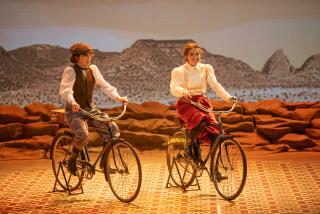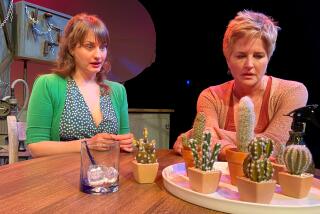Critic’s Notebook: Story and score grab hands as they venture ‘Into the Woods’
No one would accuse me of being the outdoorsy type, but on consecutive Saturdays in July, I ventured deep into Stephen Sondheim and James Lapine’s enchanted woods, where Cinderella, Little Red Ridinghood, beanstalk-shimmying Jack, captive Rapunzel, the childless Baker and his wife and a malicious witch chase their dreams down tree-darkened paths.
My journey began in San Diego, where Fiasco Theater’s lauded production of “Into the Woods” is playing at the Old Globe through Aug. 17, and concluded here in Ashland, where a superb revival at the Oregon Shakespeare Festival is being presented al fresco at the Allen Elizabethan Theatre through Oct. 11.
Travel in fables traditionally results in some privileged knowledge for the traveler, and the nugget of wisdom that I took away from my West Coast expedition is one that answers a question posed by Richard Strauss in his opera “Capriccio” about the hierarchy of poetry and music. Through these different interpretations of the same American musical — one of the rare Sondheim works that is more popular with audiences than with critics — I discovered that it’s not about the primacy of the book or the score. What matters is how they carry each other aloft, lift each other higher.
Fiasco’s production of “Into the Woods,” which began at the McCarter Theatre Center and was directed by company members Noah Brody and Ben Steinfeld, offers a stripped-down version of this musical retelling of classic fairy tales for modern day neurotics.
This staging by a troupe that has established its reputation through the imaginative verve of its ensemble Shakespeare productions focuses its playful attention on Lapine’s book, treating Sondheim’s score as though it were an adjunct to the dialogue.
There were no showstoppers at the Old Globe, where “Into the Woods” was first produced in 1986. Musical grandstanding, a lingering temptation with the show, was not permitted. Song was made subservient to story. The tomfoolery of make-believe was king.
This approach, beyond playing to Fiasco’s rambunctious strengths, was clearly intended to result in a more integrated “Into the Woods.” Critics have had problems with the way the score, which can seem recessive by Sondheim standards, suddenly erupts with numbers that aren’t always ideally suited to the character or the moment (for example, the witch’s weirdly didactic song in Act 2).
But sometimes chiropractic adjustments with a play or musical can throw other elements out of whack. Fiasco’s re-imagining, while genially exploiting the narrative zaniness with a conspiratorial wink, inadvertently exposes the tangle of Lapine’s book.
The “orchestra,” led by music director Matt Castle on piano, is so reduced, consisting of double-duty cast members, that the music isn’t able to provide lush rescue from the book’s occasional illogic and flat-footedness. The singing too is a mixed bag, which works in the sense that we don’t necessarily expect these familiar characters from our childhood to wow us with their vocal prowess, but virtuosity is never a liability with Sondheim.
Having not seen “Into the Wood” in a number of years and recalling the astringent critical take of even as avowed a Sondheim admirer as Frank Rich, who wrote that the “interlocking stories, coincidences, surprise reunions and close calls do not fall gracefully into farcical place,” I accepted that “Into the Woods” might just be fundamentally flawed, a show with magnificent elements that doesn’t cohere into a magnificent whole.
But I should know better than to draw conclusions from one theatrical outing. I recall sitting through a production of Ibsen’s “A Doll’s House” and thinking to myself that the play is embarrassingly creaky only to see the sensational Janet McTeer portray Nora on Broadway the same year in a revival that made Ibsen seem like the most startlingly urgent voice in the contemporary theater.
A similar thing happened in Ashland, where OSF’s “Into the Woods” exhibited a poise that I frankly didn’t think it possessed. How is such balance achieved? Largely through the buoyant direction of Amanda Dehnert, who also serves as music director. Through her artful calibrations, speech and song find a rare harmony.
Like Fiasco’s co-directors, Dehnert has extensive experience with Shakespeare. She’s comfortable with navigating groups of characters on a theatrical stage rooted more in metaphor than realistic detail. The cast at OSF is significantly larger than Fiasco’s, but the playful spirit is the same.
Horses for the princes to ride are made from bicycles rather than sticks. Milky White, the old cow Jack is forced to sell, is played by an actress of a certain age rather than a more youthful actor. The Wolf is shared by two performers, one serving as the voice, the other as the body (imagine an old Grateful Dead fan dressed for hunting).
Much like Fiasco’s staging, Dehnert’s production asks the audience to frolicsomely go along with its whimsy. Cinderella’s evil step-sisters are decked in gowns designed by Linda Roethke that could be described as postmodern suburban couture. The narrator, a perfect Anthony Heald, springs up not as a dramatic contrivance or shortcut but as a completely reasonable addition to this fantasy jamboree.
But it was the musical richness that provided the fuel for this fairy-tale trip that profoundly resonates with the unconscious just as Bruno Bettelheim said it was supposed to. Sondheim has insisted that Carl Jung was the bigger influence on “Into the Woods,” but it was Bettelheim, no advocate of uncomplicated feel-good endings, who was troubled by the “widespread refusal to let children know that the source of much that goes wrong in life is due to our very natures ….”
At OSF, the ethical dimension of Lapine’s book — the way characters compromise their consciences to get what they want — was more clearly discerned. But it was the beauty of the singing that melded the moral and emotional aspects of “Into the Woods” into a seamless vision.
Unfair as it is to single out individual performers in this ace ensemble, let me at least acknowledge by name Jennie Greenberry (a star in the making) as Cinderella, Royer Bockus as a soaring Rapunzel, Miles Fletcher as amiable Jack, Miriam A. Laube as a humorously menacing wickedly Witch, Kjerstine Rose Anderson as an uproarious Little Red Ridinghood and Javier Muñoz and Rachael Warren as the modern-seeming Baker and Baker’s Wife.
How the Disney film coming out later this year will approach the musical is anyone’s guess. The trailer makes it worryingly seem like a straight drama with unusually luxuriant underscoring. Let’s hope this is strictly a marketing move, for my recent wanderings have shown me that words and music must enter Sondheim and Lapine’s supernatural woods hand in hand.
More to Read
The biggest entertainment stories
Get our big stories about Hollywood, film, television, music, arts, culture and more right in your inbox as soon as they publish.
You may occasionally receive promotional content from the Los Angeles Times.







